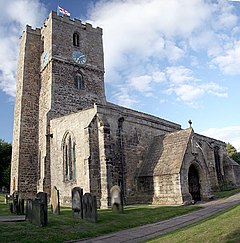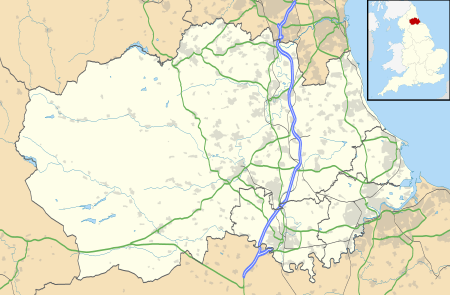Staindrop
Staindrop is a large village and civil parish in County Durham, England. It is situated approximately 6 miles (9.7 km) north east of Barnard Castle, on the A688 road. According to the 2011 UK Census the population was 1,310, this includes the hamlets of Cleatlam and Killerby.[2]
| Staindrop | |
|---|---|
 St Mary's Church, Staindrop | |
 Staindrop Location within County Durham | |
| Population | 1,310 [1] |
| OS grid reference | NZ293106 |
| Unitary authority | |
| Ceremonial county | |
| Region | |
| Country | England |
| Sovereign state | United Kingdom |
| Post town | Darlington |
| Postcode district | DL2 |
| Police | Durham |
| Fire | County Durham and Darlington |
| Ambulance | North East |
| UK Parliament | |
History
Around the year 1018, King Canute gave the manors of Raby and Staindrop to Durham Priory.[3] In 1131 Prior Algar granted the manor to an Anglo-Saxon named Dolfin[4] "son of Uhtred", the earliest recorded direct male ancestor of the great Neville family which built as their seat Raby Castle in the north part of the manor.[5][6] The grant was possibly merely a confirmation of the holding by this family from before the Norman Conquest of 1066.[7] When doing homage to the Prior for his holding he reserved his homage to the kings of England and of Scotland and to the Bishop of Durham and was "no doubt a man of consequence", probably an aristocratic Northumbrian of high birth.[8] In February 1203-4 King John confirmed to the prior and convent all their privileges and vast possessions, including "Staindrop and Staindropshire with the church".[9]
Notable buildings
Perhaps the most famous building in Staindrop is that of Raby Castle, a medieval castle surrounded by 200 acres of deer park, situated 1.5 miles (2.4 km) north of the village, it was built in the late 14th century by John Neville, 3rd Baron Neville and remains a private home, the seat of the Vane family, the Barons Barnard.[10] Raby Old Lodge dates back to the 14th century, and was once an outpost of Raby Castle, it was extensively altered between 1897-1899, it is now used as holiday accomodation.[11]
Other buildings and historic features of note include Scarth Hall, built as the village hall in 1875 and used during the Second World War to provide NAAFI facilities to soldiers stationed in Staindrop, it is now used as a community hub after undergoing refurbishment in 2016.[12] Snotterton Hall was a former fortified manor house dating back to the 15th century, demolished in 1831 and now rebuilt as a farmhouse.[13]
Religion
The Church of England parish church of St Mary (formerly dedicated to St. Gregory) are Anglo-Saxon, built in the 10th or 11th century. The church contains monuments including effigies of members of the Neville family, it underwent restoration around 1849.[14][15] A Congregational chapel also stood from 1868 until the 1970s.[16]
Governance
Staindrop was part of the local government district of Teesdale from 1974 before it was abolished as part of the 2009 structural changes to local government in England. For the purposes of Durham County Council elections, the village is located in the Barnard Castle East ward.
The village lies within the Bishop Auckland parliamentary constituency, which is under the control of the Conservative Party. The current Member of Parliament, since the 2019 general election, is Dehenna Davison.
Community and culture
The village has two schools, Staindrop Church of England Primary School with approximately to 170 pupils aged 3-11,[17] and Staindrop School, a coeducational secondary school with over 500 pupils aged 11-16, it was converted to academy status in 2011, the academy also houses a community gym, opened in 2020.[18][19]
The last remaining public house,The Wheatsheaf is a former coaching inn,[20] former pubs include The Black Swan, and The Royal Oak. Other amenities in the village include a SPAR convenience store, a newsagent housing the local post office, tea rooms, hairdressers and several holiday cottages.[21]
The Staindrop Carnival, an annual parade and fair, celebrated its centenary in 2020.[22] The village football team, Staindrop F.C. play in the Wear Valley Sunday League, an affiliate of the Durham County Football Association. Raby Castle Cricket Club play in the Darlington & District Cricket League A, having remained unbeaten and winning the league title in the 2019 season.[23]
Notable people
The surveyor Jeremiah Dixon, who with Charles Mason calculated and laid out the Mason–Dixon line in North America, is buried in Staindrop. His unmarked grave is in the Quaker burial ground adjoining the old Friends' Meeting House. Thomas Pynchon's historical fiction novel Mason & Dixon mentions Staindrop as containing Jeremiah Dixon's favourite public house.[24]
- Birthplace of Charles Bungay Fawcett, on 25th August, 1883.[25]
- Birthplace of Charles Wilbraham Watson Ford, on 17th July, 1896.
- Major William Kemp Trotter, a former Deputy Lieutenant of County Durham, and his wife Mary Holcroft.[26]
References
- "Parish population 2011". Retrieved 6 July 2015.
- "Parish population 2011". Retrieved 6 July 2015.
- 'The city of Durham: Introduction (2 of 3)', in A History of the County of Durham: Volume 3, ed. William Page (London, 1928), pp. 16-28. http://www.british-history.ac.uk/vch/durham/vol3/pp16-28
- John Horace Round, Feudal England: Historical Studies on the XIth and XIIth Centuries, 1895, p.490, Origin of the Nevilles
- Christian Drummond Liddy
- Under the Nevilles the estate of Staindrop became the lordship of Raby, See Craster, HHE, ‘The patrimony of St Cuthbert’, English Historical Review, 69 (1954), p.196
- Christian Drummond Liddy, The Bishopric of Durham in the Late Middle Ages, p.33
- Round
- 'Houses of Benedictine monks: Priory of St Cuthbert, Durham (later Durham cathedral)', in A History of the County of Durham: Volume 2, ed. William Page (London, 1907), pp. 86-103. http://www.british-history.ac.uk/vch/durham/vol2/pp86-103
- "Raby Estates, Co. Durham and Shropshire". Raby Estates. Retrieved 2020-07-30.
- Durham County Council, webadmin@durham gov uk (2016-11-04). "Site Details". Cite journal requires
|journal=(help) - "About". Scarth Hall, Staindrop. 2016-06-29. Retrieved 2020-07-30.
- "Snotterton Hall, Staindrop (The Gatehouse Record)". www.gatehouse-gazetteer.info. Retrieved 2020-07-30.
- "History". www.stmarysstaindrop.org.uk. Retrieved 2020-07-30.
- "History of Staindrop". staindrop.parish.durham.gov.uk. Retrieved 2020-07-30.
- "Letters: Is this the first photo of Staindrop?". The Northern Echo. Retrieved 2020-07-30.
- enquiries@ofsted.gov.uk, Ofsted Communications Team (2019-07-13). "Find an inspection report and registered childcare". reports.ofsted.gov.uk. Retrieved 2020-07-30.
- "About Us". Staindrop Academy. Retrieved 2020-07-30.
- "Six months' free membership of community gym". www.teesdalemercury.co.uk. Retrieved 2020-07-30.
- "Wheatsheaf, Staindrop". whatpub.com. Retrieved 2020-07-30.
- "Local Businesses". staindrop.parish.durham.gov.uk. Retrieved 2020-07-30.
- "Urgent plea for volunteers to safeguard carnival future". www.teesdalemercury.co.uk. Retrieved 2020-07-30.
- "Raby CC celebrate title success at awards evening". www.teesdalemercury.co.uk. Retrieved 2020-07-30.
- Robinson, H. W. (1950). "Jeremiah Dixon (1733-1779): A Biographical Note". Proceedings of the American Philosophical Society. 94 (3): 272–274. ISSN 0003-049X.
- "Charles Bungay Fawcett". Transactions and Papers (Institute of British Geographers) (18): xi–xiii. 1952. ISSN 1478-4017.
- "Person Page". www.thepeerage.com. Retrieved 2020-07-30.